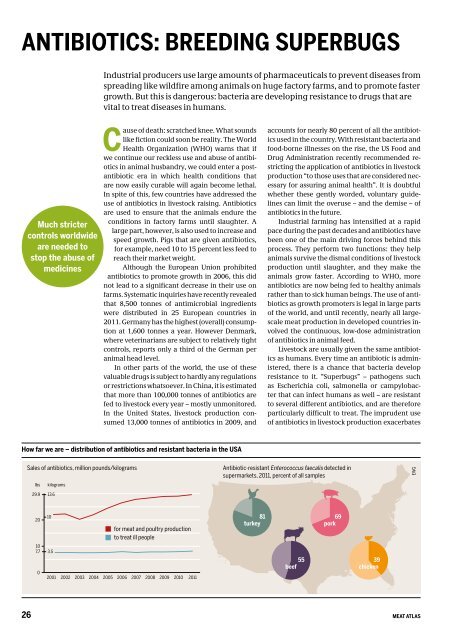1jjtwKx
1jjtwKx
1jjtwKx
Create successful ePaper yourself
Turn your PDF publications into a flip-book with our unique Google optimized e-Paper software.
ANTIBIOTICS: BREEDING SUPERBUGSIndustrial producers use large amounts of pharmaceuticals to prevent diseases fromspreading like wildfire among animals on huge factory farms, and to promote fastergrowth. But this is dangerous: bacteria are developing resistance to drugs that arevital to treat diseases in humans.Much strictercontrols worldwideare needed tostop the abuse ofmedicinesCause of death: scratched knee. What soundslike fiction could soon be reality. The WorldHealth Organization (WHO) warns that ifwe continue our reckless use and abuse of antibioticsin animal husbandry, we could enter a postantibioticera in which health conditions thatare now easily curable will again become lethal.In spite of this, few countries have addressed theuse of antibiotics in livestock raising. Antibioticsare used to ensure that the animals endure theconditions in factory farms until slaughter. Alarge part, however, is also used to increase andspeed growth. Pigs that are given antibiotics,for example, need 10 to 15 percent less feed toreach their market weight.Although the European Union prohibitedantibiotics to promote growth in 2006, this didnot lead to a significant decrease in their use onfarms. Systematic inquiries have recently revealedthat 8,500 tonnes of antimicrobial ingredientswere distributed in 25 European countries in2011. Germany has the highest (overall) consumptionat 1,600 tonnes a year. However Denmark,where veterinarians are subject to relatively tightcontrols, reports only a third of the German peranimal head level.In other parts of the world, the use of thesevaluable drugs is subject to hardly any regulationsor restrictions whatsoever. In China, it is estimatedthat more than 100,000 tonnes of antibiotics arefed to livestock every year – mostly unmonitored.In the United States, livestock production consumed13,000 tonnes of antibiotics in 2009, andaccounts for nearly 80 percent of all the antibioticsused in the country. With resistant bacteria andfood-borne illnesses on the rise, the US Food andDrug Administration recently recommended restrictingthe application of antibiotics in livestockproduction “to those uses that are considered necessaryfor assuring animal health”. It is doubtfulwhether these gently worded, voluntary guidelinescan limit the overuse – and the demise – ofantibiotics in the future.Industrial farming has intensified at a rapidpace during the past decades and antibiotics havebeen one of the main driving forces behind thisprocess. They perform two functions: they helpanimals survive the dismal conditions of livestockproduction until slaughter, and they make theanimals grow faster. According to WHO, moreantibiotics are now being fed to healthy animalsrather than to sick human beings. The use of antibioticsas growth promoters is legal in large partsof the world, and until recently, nearly all largescalemeat production in developed countries involvedthe continuous, low-dose administrationof antibiotics in animal feed.Livestock are usually given the same antibioticsas humans. Every time an antibiotic is administered,there is a chance that bacteria developresistance to it. “Superbugs” – pathogens suchas Escherichia coli, salmonella or campylobacterthat can infect humans as well – are resistantto several different antibiotics, and are thereforeparticularly difficult to treat. The imprudent useof antibiotics in livestock production exacerbatesHow far we are – distribution of antibiotics and resistant bacteria in the USASales of antibiotics, million pounds/kilogramslbs kilograms29.9 13.6Antibiotic-resistant Enterococcus faecalis detected insupermarkets, 2011, percent of all samplesEWG2010for meat and poultry productionto treat ill people81turkey69pork107.703.52001 2002 2003 2004 2005 2006 2007 2008 2009 2010 201155beef39chicken26MEAT ATLAS


